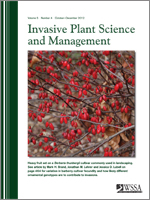Bushkiller (Cayratia japonica) is a herbaceous, perennial vine that reproduces from seed and vegetative root structures within its native range. However, this species is considered invasive in the United States due to prolific shoot production, which can overtop surrounding vegetation. Cultural control practices, such as mulching, have been observed to further the spread of this species through regeneration of root fragments. Research was conducted to determine the regenerative capacity of bushkiller root fragments (1 to 7 cm; 2.5 to 18 inches) buried at various depths (0 to 40 cm). Root length and planting depth affected leaf number, shoot number, plant height, and shoot biomass. Bushkiller leaf density, shoot density, plant height, and dry weight increased as root fragment length increased from 1 to 7 cm; conversely, these variables decreased as planting depth increased from 0 to 40 cm. Results indicate bushkiller regeneration capacity from root fragments is extremely high and control practices that fragment roots should be avoided to reduce further spread.
Nomenclature: Bushkiller, Cayratia japonica (Thunb.) Gagnep
Management Implications: Bushkiller is an invasive, perennial vine that grows rapidly and overtops surrounding vegetation. It has invaded several states in the Southern United States and several recently reported infestations have elevated concern about this species. Research was conducted to determine the regenerative capacity of bushkiller roots. Bushkiller roots just 2.8 inches in length produced over 1 shoot around 10 inches in length with approximately 13 leaves by just 34 days after planting. Even though smaller roots produced fewer and shorter shoots, vegetative reproduction was observed down to the smallest root fragment evaluated, 0.4 inches in length. Root fragments were also able to reproduce when planted as deep as 16 inches. Based upon this data, established bushkiller would be extremely tolerant of single disturbance events including cultivation, mowing, mechanical removal of shoots, grazing, and application of non-systemic herbicides. Further, disturbance that results in root fragmentation may increase stem density. Our results also suggest that fragmented roots would readily form new infestations when moved as soil contact is maintained.





